The $1.9 billion renewal project is spectacular, except for those who live around it.
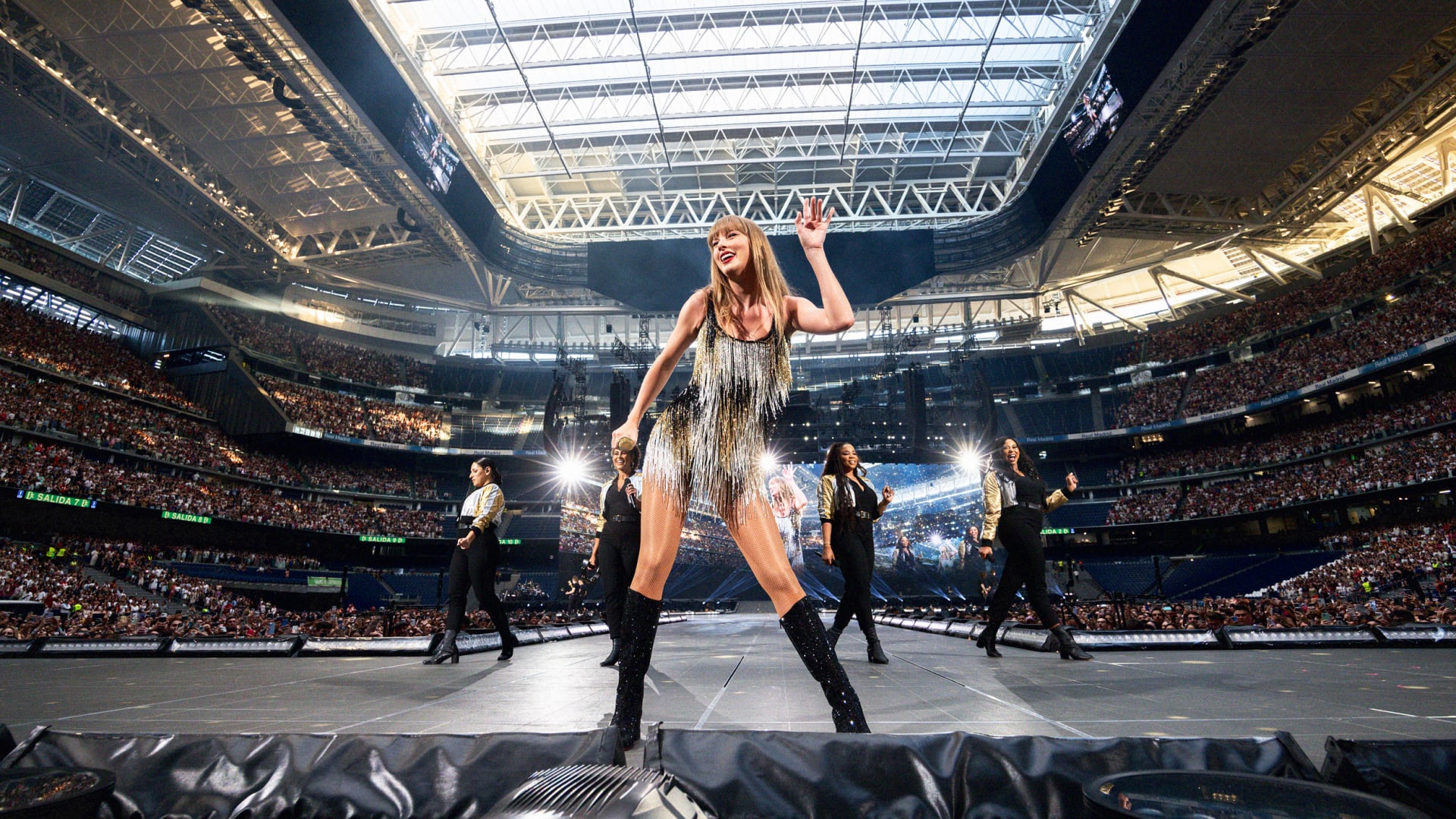
Taylor Swift performs on stage during Taylor Swift | The Eras Tour at Santiago Bernabéu Stadium on May 29, 2024 in Madrid, Spain. [Photo: Xavi Torrent/TAS24/Getty Images for TAS Rights Management]
When the most popular sports team on the planet finished its new stadium, everything seemed perfect. With its old brutalist concrete structure now cladded in a new wraparound facade made of smoothly curved stainless steel louvers, it looked like a sci-fi spaceship ready to take the best soccer club of the 20th century into the 21st. Every member and fan of Real Madrid (myself included) was proud of the club’s new crown jewel. Then, on May 29, Taylor Swift came to sing and everything went to hell. After inaugurating the space as a concert venue, a regular cadence of major act musicians followed. And now, tens of thousands of fans have ruined the venue’s surroundings, while partying at thundering decibels that keep locals awake till 1 a.m. The new architectural icon has turned out to be a poisonous pill for the city.
The soccer club—the world’s most valued and one of the last sports teams in the world owned by 99,781 members rather than a private owner—had spent more than six years and $1.91 billion renovating the legendary Santiago Bernabéu soccer cathedral into a 82,000-spectator venue. It was redesigned to host soccer matches or any other imaginable event, from music concerts to conventions, thanks to a feat of mechanical engineering that swaps out its perfect but fragile natural grass pitch for a solid concrete ground at the push of a button.
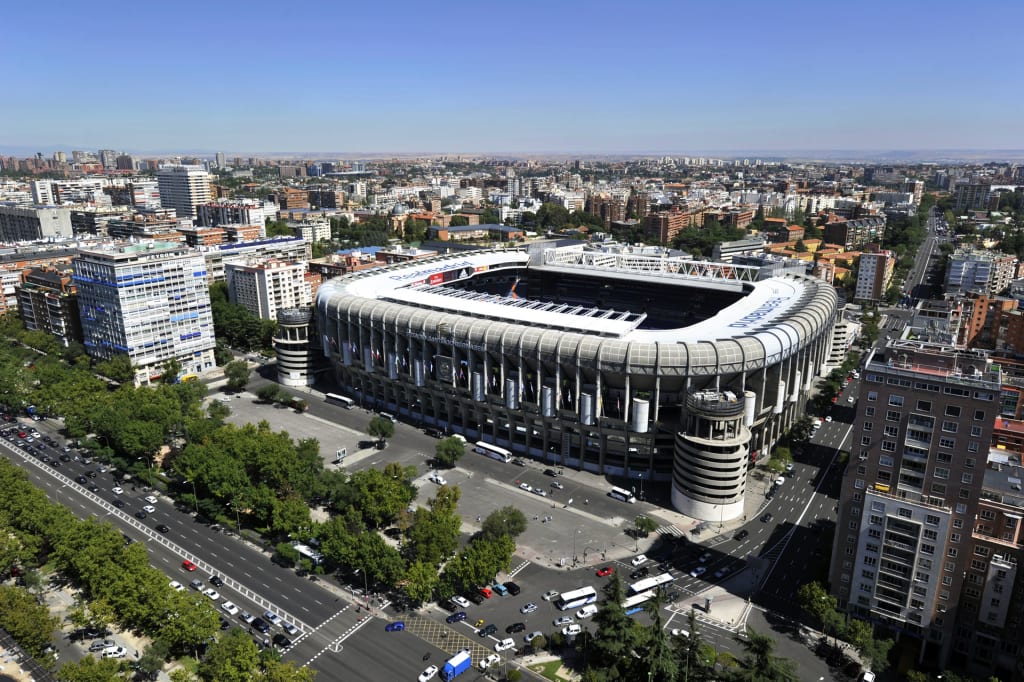
Designed by L35 Arquitectos, gmp Architekten, and Ribas & Ribas Arquitectos after an international competition in 2014, the new Bernabéu’s was reimagined with two objectives in mind. The first was to “humanize this macrostructure,” according to Tristán López-Chicheri, CEO of L35 Architects. López-Chicheri thinks that its new shape—which will eventually display live Real Madrid’s games to outsiders using LED projection—provides “a flexible and recognizable identity while reflecting the city’s activity through its reflective surfaces.” The façade, he says, enhances its aesthetic appeal and improves the natural ventilation thanks to the parametrized steel louvers that surround it.
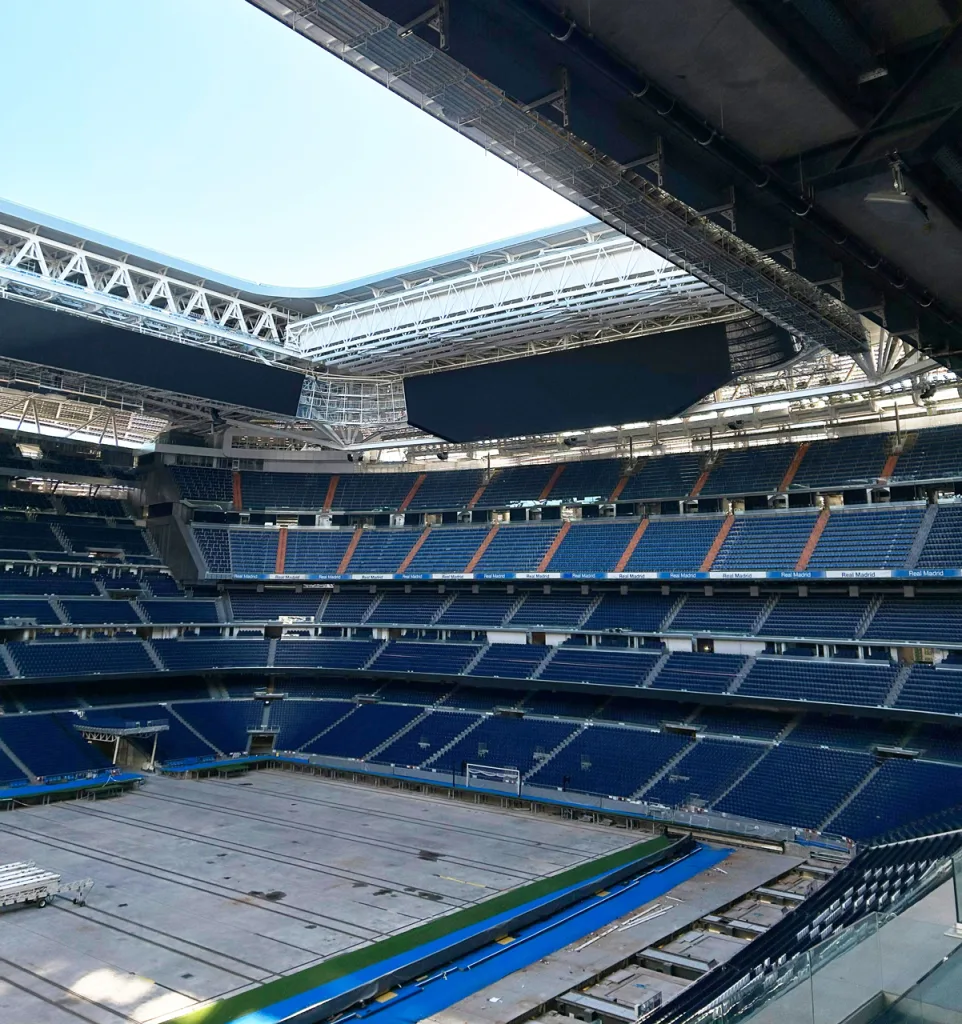
The second objective, and most important for Real Madrid’s fortunes, was to transcend hosting soccer to become a multifunctional space. The renovation had to include a fully retractable roof to, primarily, provide protection from the elements, but also multiply the roaring of the fans to intimidate visiting teams. The movable translucent roof is supported by two massive steel trusses that span 577 feet across the stadium—which was constructed using 800-tonne cranes—perched on four new towers built on deep foundations. The roof enhances the spectator experience with an impressive 360-degree LED screen and the latest tech in lighting and sound systems. In total, the construction crews used 33,000 tonnes of steel to refurbish the stadium, the equivalent of 120 Airbus A380s.
The other element to achieve its new multifunctional capability is the new retractable pitch. Developed by the engineering firm Sener, the system—which was first implemented in Tottenham Hotspur FC’s stadium in 2019—features a fully retractable pitch that can be stored in an underground chamber, known as the Hypogeum, located approximately 98 feetbelow the stadium’s main grandstand.
The pitch is divided into six large sections, each mounted on a system of high-strength steel rails and specialized rollers. These sections can be moved both horizontally and vertically, facilitated by powerful electric motors and hydraulic systems. The combined weight of these sections amounts to several hundred tons, requiring a robust and precise movement system. The rails ensure that the sections glide smoothly into the Hypogeum for storage or back into position for use during football matches.
The Hypogeum is not merely a holding area but a sophisticated facility equipped with full HVAC (Heating, Ventilation, and Air Conditioning) systems. These systems are crucial for maintaining the grass in optimal condition while it is stored. The chamber includes advanced climate control, artificial lighting, and irrigation systems that regulate soil moisture and temperature. This environment allows the grass to be preserved in perfect condition, with groundskeepers able to access the pitch for necessary maintenance tasks such as mowing and treatment.
The system takes approximately 25 minutes to fully retract or reinstall the grass surface. The system’s electric motors and hydraulic lifts work in tandem to move the pitch sections smoothly along the rails. This operation is essential for minimizing downtime between events and ensuring the stadium can be swiftly adapted for different uses.
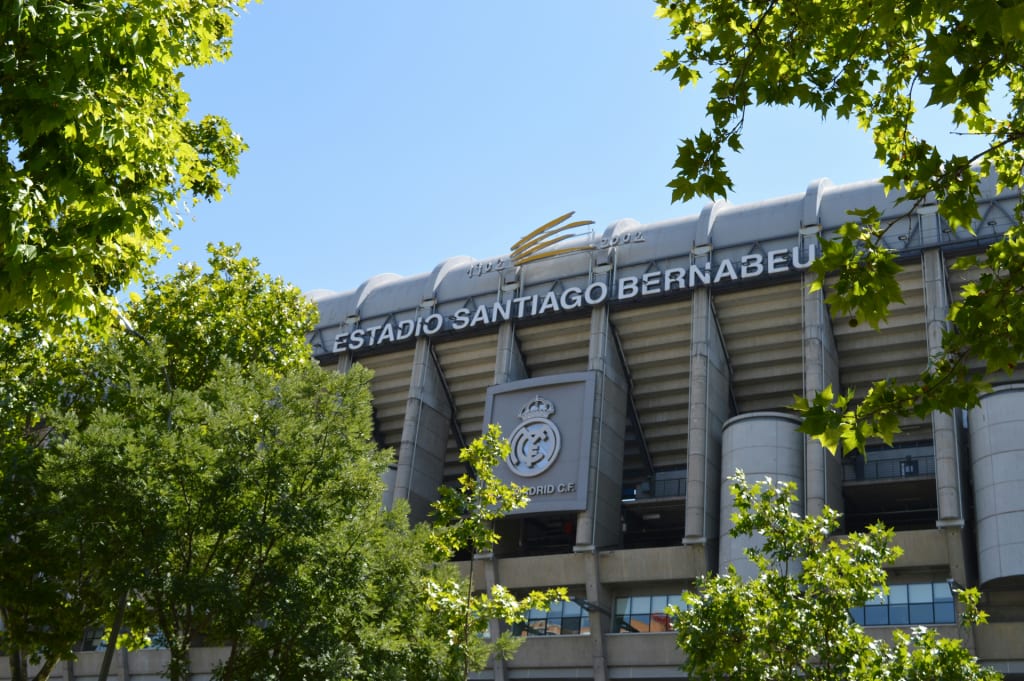
DESTRUCTION OF THE CITY SPIRIT
The system works great. It is actually impressive to see it in action. Which brings us back to Taylor Swift and the parade of musicians who have been playing multiple days every week since she inaugurated the Santiagos Bernabéu’s new multifunctional life with her global Eras tour.
The Bernabéu’s neighbors are used to the team’s games. They don’t happen often: Real Madrid plays one LaLiga match—Spain’s top soccer competition—on weekends every other week, on Saturday, Sunday, or Monday. Then there’s the occasional midweek game for the two other tournaments the team plays: The European Champions League and the other national tournament, the Copa del Rey. The games’ noise is acceptable. You can only hear the fans screaming the goals, the announcer introducing the players, or the near-misses. Fans—who are not rowdy but regular Joes and Janes—arrive about an hour before the kickoff. The games lasts for about two hours—including the half-time break—and then they all are gone about 40 minutes after all is over.
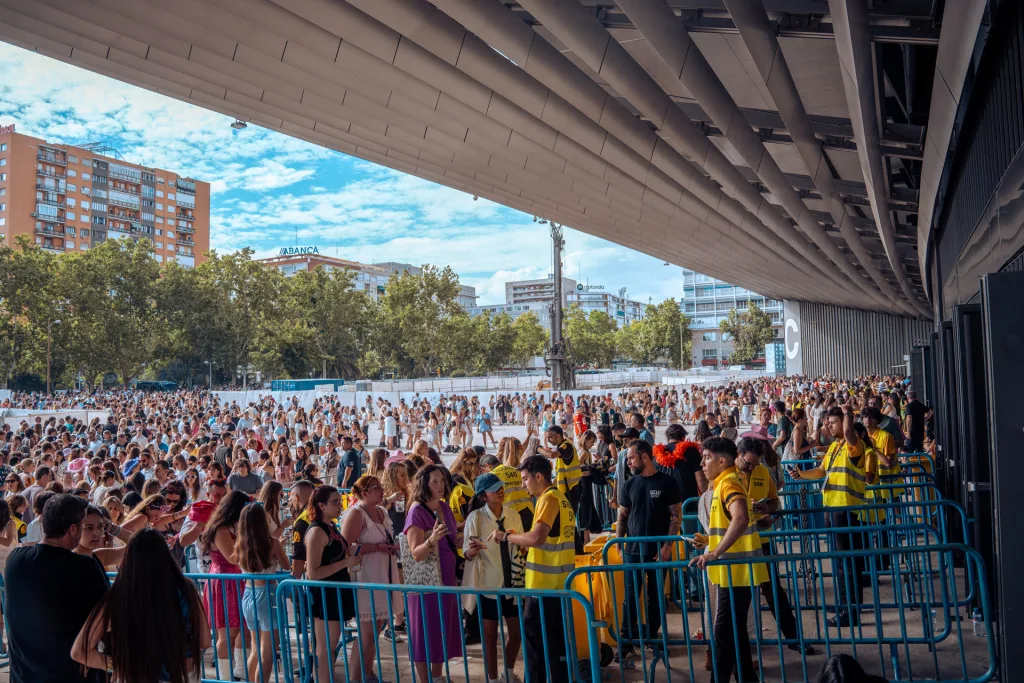
But from the day Swift performed, it was clear that the relative tranquility of soccer games was not going to be the norm for concerts. Everyone who lived in a one mile radius around the stadium realized that their worst fears had become a reality. That includes me: I live 1,700 feet from the Santiago Bernabéu, with only a small church in between the stadium and my apartment building. I could clearly hear the sound testing during the day. When the night came, the noise became unbearable, reaching 80 decibels until about 1 a.m., way over the 53 dB permitted by city ordinances. Local police’s phones were on fire as neighbors called to complain.
The noise only grew after those two first concerts. Following Taylor Swift’s performances at the Santiago Bernabéu Stadium in May, Argentine rapper Duki performed in June. In July, the stadium hosted a series of concerts by Colombian reggaeton star Karol G, who performed four shows in four days. Those two acts increased the number of decibels, exceeding the 90db mark measured from the apartments right next to the stadium. That is as loud as a hairdryer or a powertool near your head, enough to physically rattle all glass windows around the venue.
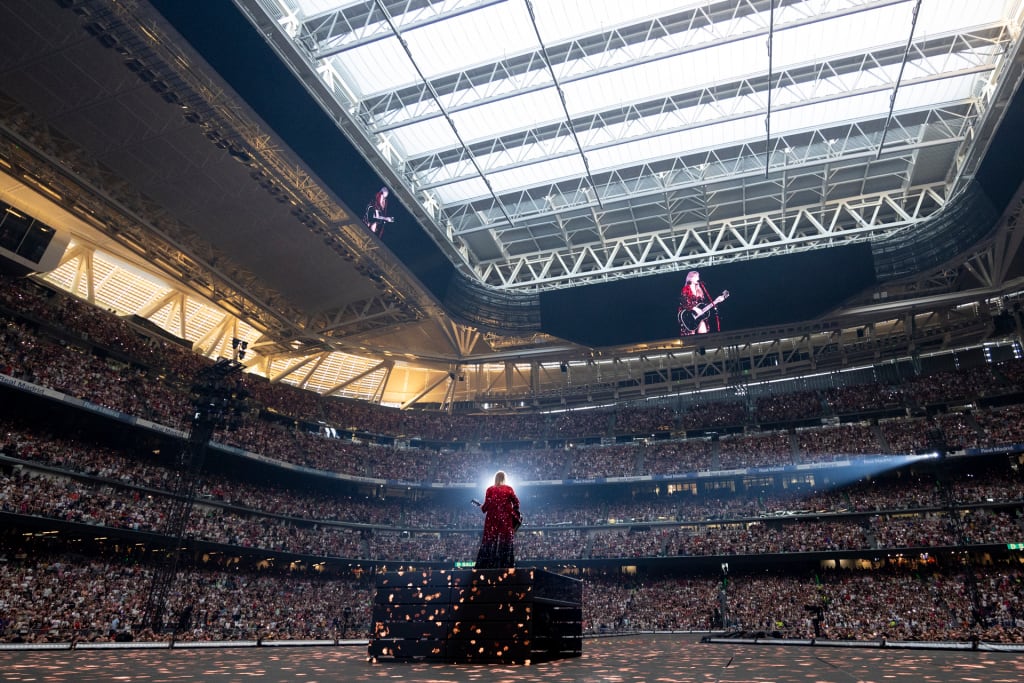
The deafening noise is not the only problem. Days before the event, you can see massive fleets of logistic trucks and buses parked all over the wide avenues and streets surrounding the venue. This wreaks havoc that extends way beyond the neighborhood, rippling all over the city’s streets: The stadium is located right on Paseo de la Castellana—a wide avenue that is Madrid’s biggest traffic artery, traversing the city north to south—in the heart of the Chamartín neighborhood, which may be the equivalent to New York’s Upper East Side.
Beyond the traffic nightmare, the flow of people is the other major source of pain for the neighbors. These concerts bring a lot more than 80,000 music fans into the neighborhood. Thousands come without a ticket, just to hang out with others and to try to catch a glance at their favorite star entering the stadium’s parking in their limos. And the Swifties were relatively civil. Duki and Karol G’s fans were more rowdy. Drunken visitors trashed “el barrio” with each concert, peeing in public, dropping trash, and destroying plants and urban furniture—regardless of the police controls or the municipal cleaning crews that attempt to mitigate the damage. At one point, a 42-year-old man was beaten to death by a young fan. Needless to say, everyone around the stadium is desperate for a solution to this chaos.
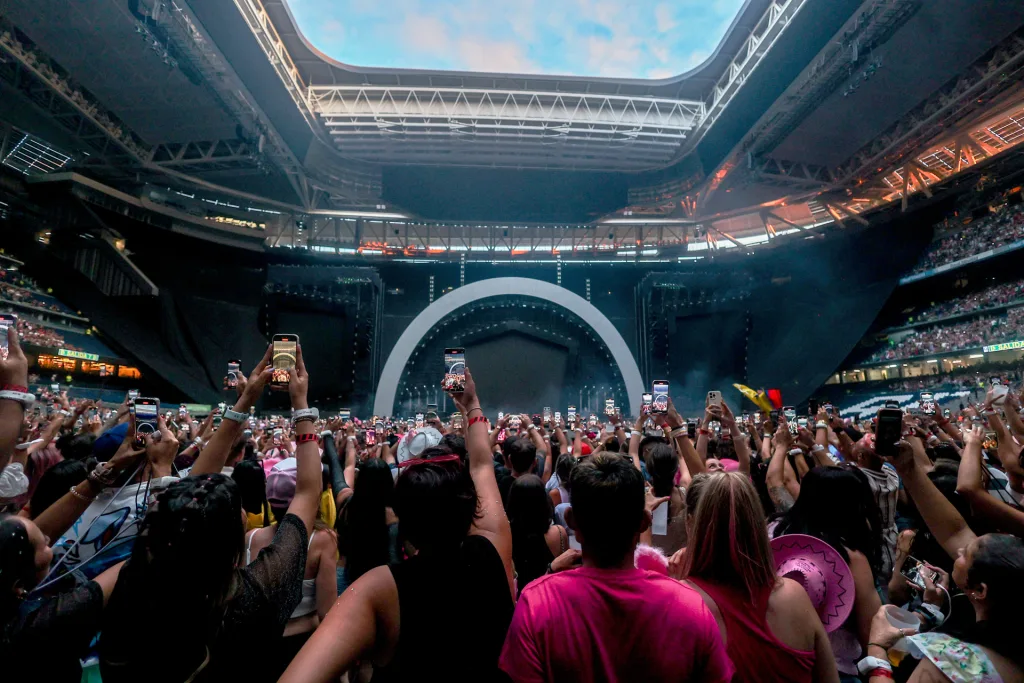
A DISASTER FORETOLD
Desperate to save its multifunctional cash cow plan, Real Madrid has asked the neighbors to be patient about the problem. The City Council and the club now say they have a plan: Lowering the power of the sound system and limiting the number of concerts to “20 extraordinary events.” The club is promising they are working to design and install sound suppression systems to lower the noise level, but experts are skeptical about its ability to do that in a venue that, by law, has to be open to the street to allow for ventilation. Most neighbors, myself included, can’t understand how sound mitigation was not implemented in the first place, since the objective was to turn the Santiago Bernabéu into this type of venue.
This was the chronicle of an urban disaster foretold. Everyone feared this was going to happen, yet nobody, including the many fans who live around the stadium, can understand how Real Madrid has made so many mistakes and planned so poorly. Keep in mind that Real Madrid is not only the most valuable soccer team on the planet, but also one of the most powerful institutions in Europe. And Florentino Pérez—the club’s president and also Chairman and majority stake owner of ACS Group, one of the biggest civil engineering companies in Europe—is perhaps the most powerful person in Spain after the President. Which seems to be why Madrid’s Mayor José Luis Martínez-Almeida is trying to walk a fine line between keeping him and the neighbors happy.
But the neighborhood—which is home to a who’s who of Madrid’s financial, business, and law worlds elites—is having none of that. They don’t believe the club or the city and, just two weeks ago, a Madrid judge accepted a lawsuit from the “Association of Neighbors Affected by the Bernabéu” against the club over excessive noise and vibrations from concerts at the Santiago Bernabéu Stadium since the first Swiftquake. The neighbors argue that the city council’s 2019 construction license did not include non-football events, and Real Madrid did not conduct noise prevention studies for concerts.
The court found sufficient evidence to proceed with the case but did not accept complaints against the Madrid City Council or its officials, which the residents plan to appeal. José Ángel Sánchez Periáñez of Real Madrid Estadio S.L.—the company that manages the stadium—and a representative are summoned to testify in October. The judge has also requested noise measurement records and the number of noise complaints during the period of April to July 2024, the month where the lawsuit was presented.
Since the events have very clearly violated city ordinances again and again, it’s probable that they will win the case. Previously, residents won a court case halting construction of a giant tunnel and parking at the stadium due to environmental concerns, which also prompted another legal effort against the city in the European Union for allegedly misusing public funds to help Real Madrid in building that infrastructure, which the club was going to privately exploit for the next 40 years.
Meanwhile, for those of us who live in the neighborhood, the concert situation is not improving and it doesn’t seem like it’s going to end well. Even if Real Madrid manages to lower the noise levels, the loud sound will still be there as will the hundreds of thousands of music fans invading the space every week, causing disgust and huge traffic jams in the name of wild capitalism. It is a terrible way to destroy the outstanding heritage of a newly renovated, venerable sports landmark that has represented the city since it was finished in 1947, a true synonym for joy and celebration for citizens of Madrid and beyond.
Apply to the Most Innovative Companies Awards and be recognized as an organization driving the world forward through innovation. Early-rate deadline: Friday, August 23.
ABOUT THE AUTHOR
Jesus Diaz is a screenwriter and producer whose latest work includes the mini-documentary series Control Z: The Future to Undo, the futurist daily Novaceno, and the book The Secrets of Lego House. More

No comments:
Post a Comment